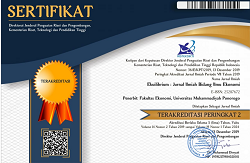Household Saving Behavior on Formal Financial Institutions in Urban and Rural Areas
DOI: 10.24269/ekuilibrium.v17i1.2022.pp40-53
Abstract
This research aimed to examine the household saving behavior on formal financial institutions in urban and rural areas. The data sources of this research from the Central Bureau of Statistics (BPS), namely the 2018 Indonesia national socio-economic survey (SUSENAS) and the 2018 Indonesia village potential survey (PODES).The research sampleswere 126 539 households in urban and 168 562 households in rural spread over 34 provinces in Indonesia. The analytical method used logistic regression to determine the household behavior in the savings ownership in a formal bank institution.Several factors that affect savings ownership included socio-demographic and institutional factors. The estimation results showed that all socio-demographic factors affected savings ownership in urban, while institutional factors, namely government bank and private banks did not have a significant effect. Otherwise, institutional factors had a significant effect on savings ownership in rural, while socio-demographic factors (house ownership) did not havea significant effect. The findings were very important to improve saving behavior and provide alternative policies related to banking infrastructure development in Indonesia.
Keywords
References
- Bernheim, B. D., & Garrett, D. M. (2003). The effects of financial education in the workplace: evidence from a survey of households. Journal of Public Economics, 87(7–8). https://doi.org/10.1016/S0047-2727(01)00184-0
- Blanc, J. le, Porpiglia, A., Teppa, F., Zhu, J., &Ziegelmeyer, M. (2016). Household Saving Behavior in the Euro Area. International Journal of Central Banking, 12(2).
- Brounen, D., Koedijk, K. G., &Pownall, R. A. J. (2016). Household financial planning and savings behavior. Journal of International Money and Finance, 69. https://doi.org/10.1016/j.jimonfin.2016.06.011
- Browning, M., & Lusardi, A. (1966). Household Saving: Micro Theories and Micro Facts. Journal of Economic Literature, 34(4), 1797–1855.
- Chamon, M., Liu, K., & Prasad, E. (2013). Income uncertainty and household savings in China. Journal of Development Economics, 105, 164–177. https://doi.org/10.1016/j.jdeveco.2013.07.014
- Dadzie, K. Q., Winston, E., & Afriyie, K. (2003). The effects of normative social belief systems and customer satisfaction on rural savings programs in Ghana. Management Decision, 41(3), 233–240. https://doi.org/10.1108/00251740310469422
- Deaton, A. (1991). Saving and Liquidity Constraints. Econometrica, 59(5), 1221. https://doi.org/10.2307/2938366
- Donkor, E., &Anane, E. (2016). Saving behaviour of citrus farmers in Ghana: implications for rural enterprise development. Development in Practice, 26(8). https://doi.org/10.1080/09614524.2016.1225671
- Engelhardt, G. v. (1996). House prices and home owner saving behavior. Regional Science and Urban Economics, 26(3–4). https://doi.org/10.1016/0166-0462(95)02118-3
- Fassil, E., & Mohammed, B. (2017). Dynamics and determinants of rural-urban migration in Southern Ethiopia. Journal of Development and Agricultural Economics, 9(12). https://doi.org/10.5897/JDAE2017.0850
- Fisher, P., &Anong, S. (2013). Health status and household saving behavior. 5, 167–177.
- Friedman, M. (1957). The Permanent Income Hypothesis. In A Theory of the Consumption Function (pp. 20–37). National Bureau of Economic Research, Inc. https://EconPapers.repec.org/RePEc:nbr:nberch:4405
- Haider, M. Z., Hossain, T., & Siddiqui, O. I. (2016). Impact of remittance on consumption and savings behavior in rural areas of Bangladesh. Journal of Business, 1(4), 25. https://doi.org/10.18533/job.v1i4.49
- Hanna, S., &Rha, J.-Y. (2000). The Effect of Household Size Changes on Credit Use An Expected Utility Approach.
- Heckman, S. J., & Hanna, S. D. (2015). Individual and Institutional Factors Related to Low-Income Household Saving Behavior. Journal of Financial Counseling and Planning, 26(2), 187–199. https://doi.org/10.1891/1052-3073.26.2.187
- Hefferan, C. (1982). Determinants and Patterns of Family Saving. Home Economics Research Journal, 11(1). https://doi.org/10.1177/1077727X8201100109
- Hounmenou, C. (2011). Striving to Save: Creating Policies for Financial Security of Low-Income Families, by Sherraden, M. S., & McBride, A. M., with Beverly, S. G. Journal of Community Practice, 19(2). https://doi.org/10.1080/10705422.2011.569277
- Keynes, J. M. (1936). The General Theory of Employment, Interest, and Money.
- Kiiza, B. (2001). Household Financial Savings Mobilisation: Empirical Evidence from Uganda. Journal of African Economics, 10(4), 390–409. https://doi.org/10.1093/jae/10.4.390
- Knoll, M. A. Z., Tamborini, C. R., & Whitman, K. (2012). I Do … Want to Save: Marriage and Retirement Savings in Young Households. Journal of Marriage and Family, 74(1), 86–100. https://doi.org/10.1111/j.1741-3737.2011.00877.x
- Lusardi, A. (2008). Household Saving Behavior: The Role of Financial Literacy, Information, and Financial Education Programs. National Bureau of Economic Research. http://www.nber.org/papers/w13824.pdf
- Maherul, S. A. (2015, August 10). DisparitasDesa Kota. Sindonews.
- Marie theresa, N. (2007). AN INVESTIGATIVE ANALYSIS INTO THE SAVING BEHAVIOUR OF POOR HOUSEHOLDS IN DEVELOPING COUNTRIES: with specific reference to South Africa. http://hdl.handle.net/11394/2081
- Markos, W. (2015). Determinants and Behaviour of Rural Household Saving: A Case of Dale Woreda, Sidama Zone. INTERNATIONAL JOURNAL OF MULTIDISCIPLINARY ADVANCED RESEARCH TRENDS, 2, 1–9.
- Modigliani, F., & Ando, A. K. (2009). TESTS OF THE LIFE CYCLE HYPOTHESIS OF SAVINGS: COMMENTS AND SUGGESTIONS1: TESTS OF THE LIFE CYCLE HYPOTHESIS OF SAVINGS. Bulletin of the Oxford University Institute of Economics & Statistics, 19(2), 99–124. https://doi.org/10.1111/j.1468-0084.1957.mp19002002.x
- Modigliani, F., &brumberg, R. (1955). Utility analysis and the consumption function: An interpretation of cross-section data. Post-Keynesian Economics, 388–436.
- Ngasuko, T. A. (2018). Determinant Factor For Household To Access Formal Financial Institution: The Study Case Susenas 2015. Munich Personal RePEcArchieve, 97995. https://mpra.ub.uni-muenchen.de/97995/
- Nguyen, V. T., & Doan, M. D. (2020). The Correlation between Financial Literacy and Personal Saving Behavior in Vietnam. Asian Economic and Financial Review, 10(6), 590–603. https://doi.org/10.18488/journal.aefr.2020.106.590.603
- Obayelu, O. A. (2012). Saving Behavior of Rural Households in Kwara State, Nigeria. SSRN Electronic Journal. https://doi.org/10.2139/ssrn.1999413
- Owen, A. L., & Pereira, J. M. (2018). Bank concentration, competition, and financial inclusion. Review of Development Finance, 8(1), 1–17. https://doi.org/10.1016/j.rdf.2018.05.001
- Pateman, T. (2011). Rural and urban areas: comparing lives using rural/urban classifications. Regional Trends, 43(1), 11–86. https://doi.org/10.1057/rt.2011.2
- Perz, S. G., Shenkin, A., Rondon, X., &Qiu, Y. (2013). Infrastructure Upgrades and Rural–Urban Connectivity: Distance Disparities in a Tri-National Frontier in the Amazon. The Professional Geographer, 65(1), 103–115. https://doi.org/10.1080/00330124.2011.639636
- Pohan, H. L., Suroso, P. C., Pattiwel, J. F., & Fordian, D. (2014). Perilaku Menabung Kelompok Masyarakat Berpenghasilan Rendah (MBR) di Perkotaan dan Perdesaan.
- Rahman, A. U., Hayat, Y., Habbib, Z., & Iqbal, J. (2011). Rural-Urban Disparities in Khyber Pakhtunkhwa Pakistan. Sahad J Agric, 27(3), 2.
- Rehman, H. ur, Faridi, M. Z., & Bashir, F. (2010). Households Saving Behaviour in Pakistan: A Case of Multan District. Pakistan Journal of Social Sciences (PJSS), 30(No. 1 (September 2010)), 17–29.
- Rha, J.-Y., Montalto, C., & Hanna, S. (2006). The effect of self-control mechanisms on household saving behavior. Journal of Financial Counseling and Planning, 17.
- Robin, H., & Brenda, C. (2016). Financial Literacy and Long- and Short-Term Financial Behavior in Different Age Groups. Journal of Financial Counseling and Planning, 27(1), 3–19.
- Seiler, V., Rudolf, M., &Krume, T. (2013). The influence of socio‐demographic variables on customer satisfaction and loyalty in the private banking industry. International Journal of Bank Marketing, 31(4), 235–258. https://doi.org/10.1108/IJBM-10-2012-0101
- Thi Minh, N., Hong Nhat, N., Trong Anh, T., Duc, P. M., & Son, L. T. (2013). emographics and Saving Behavior of Households in Rural Areas of Vietnam: An Empirical Analysis. Journal of Economics and Development, 15(2), 5–18.
- Ting, L., &Kollamparambil, U. (2015). Nature and determinants of household retirement savings behavior in South Africa. Development Southern Africa, 32(6). https://doi.org/10.1080/0376835X.2015.1063987
- Veritia, Lubis, I., Amas, P. I., & Susanto. (2019). TeoriEkonomi Makro (Vol. 1). Unpam Press.
- Wiggins, S., & Proctor, S. (2001). How Special Are Rural Areas? The Economic Implications of Location for Rural Development. Development Policy Review, 19(4), 427–436. https://doi.org/10.1111/1467-7679.00142
- Winarto, A. R., & Rapini, T. (2014). Peran Lembaga Keuangan Informal TerhadapPemberdayaanKelompokusaha Informal. JurnalEkulilibrium, 12(1).
- Wu, W. (2010). Urban Infrastructure Financing and Economic Performance in China. Urban Geography, 31(5), 648–667. https://doi.org/10.2747/0272-3638.31.5.648
- Xiao, J., & Olson, G. I. (1993). Mental Accounting and Saving Behavior. Home Economics Research Journal, 22(1). https://doi.org/10.1177/004677749302200105
- Yuh, Y., & Hanna, S. D. (2010). Which Households Think They Save? Journal of Consumer Affairs, 44(1), 70–97. https://doi.org/10.1111/j.1745-6606.2010.01158.x
- Zwane, T., Greyling, L., &Maleka, M. (2016). The Determinants Of Household Savings In South Africa: A Panel Data Approach. International Business & Economics Research Journal (IBER), 15(4). https://doi.org/10.19030/iber.v15i4.9758
Refbacks
- There are currently no refbacks.

This work is licensed under a Creative Commons Attribution-ShareAlike 4.0 International License.















